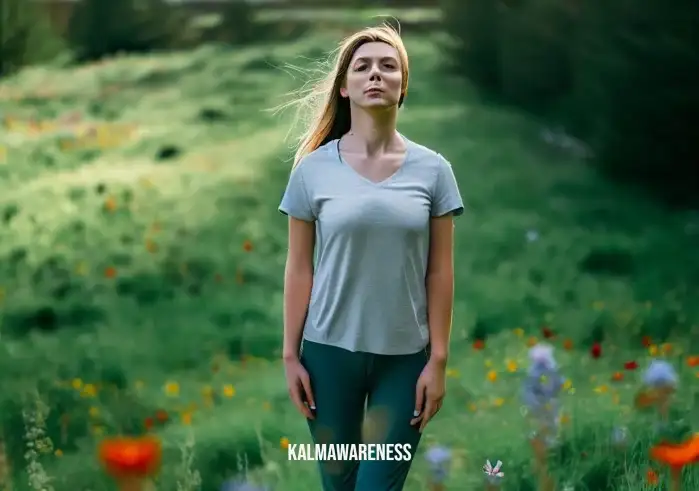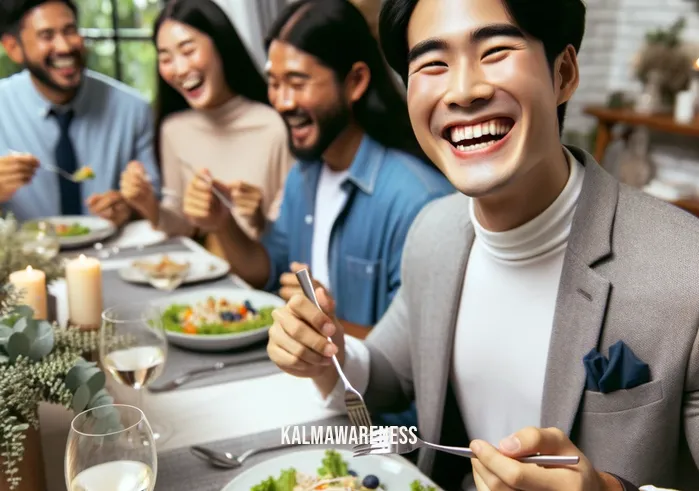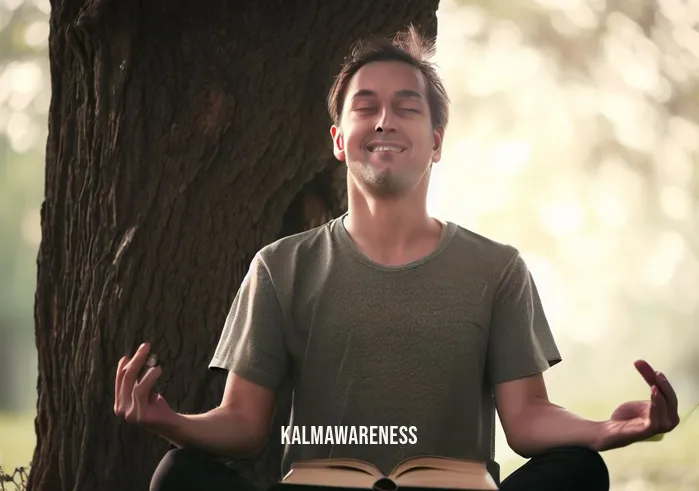Discovering Tranquility: An Introduction to Guided Meditation Mindful Movement
Welcome to a realm where inner peace, relaxation, and self-discovery coexist. This is the world of guided meditation mindful movement, an innovative practice that combines the age-old wisdom of meditation with the holistic benefits of mindful movement.
Imagine a golden orb of light gently pulsating at your heart center. This powerful image is a cornerstone of the Golden Orb Meditation method. When synchronized with breathwork and movement, it serves as a focal point that anchors your thoughts and allows you to explore the profound depths of mindfulness.
Now, let’s delve into the essence of guided meditation mindful movement.
What is Guided Meditation Mindful Movement?
Guided meditation mindful movement is an immersive practice that involves the use of mental imagery and physical movement to achieve deep relaxation, enhance mindfulness, and facilitate self-discovery.
Before venturing into this terrain, it is crucial to master the art of meditation. You might be wondering, ‘How can I meditate before shifting‘ into a state of heightened mindfulness? A step-by-step guide at our website can offer you the guidance you need.
As you become comfortable with the basics, you can start incorporating elements of mindful movement into your meditation routine. The goal is to be completely present in each movement, whether it’s a gentle stretch or a more complex sequence. This practice embodies the art of meditation preparation to prime both your mind and body for an enriching meditative experience.
With guided meditation mindful movement, your body becomes an instrument of peace and harmony.
The Role of Visualization
At the heart of this practice lies the power of visualization. In the context of meditation, it’s not just about seeing with your physical eyes, but also about perceiving with your inner vision. This mental faculty lets you tap into your imagination to create powerful images that guide your mindful movements.
Our 10-minute visualization exercise provides a comprehensive introduction to the art of visualization in meditation. It empowers you to transport yourself to a place of tranquility, even amid the daily hustle.
This blend of visualization and movement can also be incredibly healing. For instance, meditation for healing emotional pain leverages this fusion to alleviate emotional distress and cultivate self-compassion.
Benefits of Guided Meditation Mindful Movement
The practice of guided meditation mindful movement comes with a plethora of benefits:
- Stress relief: By focusing your mind on the movements and the visualizations, you can disconnect from the stresses of everyday life, leading to profound relaxation. This echoes the Deep Relaxation Meditation practice on our site.
- Enhanced mindfulness: The emphasis on movement can make it easier to stay present, fostering a deep sense of mindfulness.
- Promotes self-discovery: As you dive deeper into your practice, you begin to uncover layers of your being. This journey can reveal insights into your emotions, thoughts, and beliefs, fostering self-understanding.
We invite you to continue this journey in the next part of this article, where we delve into some beginner-friendly techniques for guided meditation mindful movement. We will also explore how this practice can enhance your daily life, and introduce you to some advanced methods such as 6-phase meditation. It’s an adventure of self-exploration and transformation. Are you ready?

Immersion into the Practice of Guided Meditation Mindful Movement
Welcome to the second chapter of our journey into the world of guided meditation mindful movement. This transformative practice intertwines the threads of meditation, visualization, and mindful movement to facilitate profound inner exploration and serenity.
A Step-by-Step Guide to Practicing Guided Meditation Mindful Movement
Before embarking on this voyage of mindful movement, it’s necessary to ground ourselves. Let’s refer to a 10-minute grounding meditation, an excellent precursor to our guided meditation mindful movement session.
With our groundwork laid, here’s a step-by-step guide to start your journey:
- Preparation: Find a quiet space free from distractions. You might want to dim the lights or light a candle to create a serene atmosphere. As mentioned in meditation made simple, having a conducive environment can significantly enhance your meditation experience.
- Posture: Whether you choose to sit, stand or lie down, ensure your posture is comfortable yet alert. The posture in breathe meditation and wellness offers a great example.
- Breath Awareness: Begin by focusing on your breath. Imagine your breath as a balloon, inflating and deflating with each inhale and exhale, just like the technique used in balloon meditation script.
- Visualization: Now, transition to visualization. You could envision a golden orb, a serene lake, or any calming image that resonates with you. You can refer to guided meditation Tara Brach, where Tara illustrates powerful visualizations.
- Mindful Movement: Incorporate gentle movements synchronized with your breath. This could be as simple as lifting your arms with an inhale and lowering them with an exhale.
Incorporating the above steps into your routine can pave the way for an enriching guided meditation mindful movement experience.
Unraveling the Layers of Mindful Movement
Guided meditation mindful movement is not confined to a set sequence of movements. You can think of it as a spectrum ranging from simple stretches to more complex sequences like yoga asanas. The common thread is mindfulness, the cornerstone of mindfulness meditation CD, where every action is intentional and imbued with awareness.
Here’s a table to better illustrate this concept:
| Movement | Description | Benefits |
|---|---|---|
| Stretching | Involves gentle movements that elongate muscles and enhance flexibility. | Promotes physical flexibility, eases tension, improves circulation. |
| Yoga Asanas | Structured poses that require balance, strength, and flexibility. | Enhances physical strength, improves balance, fosters mindfulness. |
| Qigong | A Chinese practice combining slow graceful movements, mental concentration, and breathwork. | Promotes energy balance, fosters mindfulness, enhances mental focus. |
| Walking Meditation | Involves mindful walking, being aware of each step and the contact of the foot with the ground. | Improves mindfulness, encourages physical activity, boosts mental clarity. |
No matter which form of mindful movement you choose, the key lies in maintaining a state of deep awareness and presence.
The next chapter of our article will explore how to incorporate guided meditation mindful movement into your daily routine, offering you strategies to manage stress, and enhancing your mindfulness skills. Stay tuned to continue the journey. You may find treasures in the art of like some meditative exercises. Join us in the next chapter to discover more.

Embracing Guided Meditation Mindful Movement in Daily Life
As we delve deeper into guided meditation mindful movement, we uncover a myriad of opportunities to weave this practice into our everyday lives. Chapter three of our exploration discusses practical ways to incorporate mindful movement, helping to alleviate stress and enrich our lives with a profound sense of awareness.
Infusing the Day with Mindful Movement
From the moment we awake till we drift back to sleep, opportunities for mindful movement abound. Awakening with a 10-minute visualization can set the tone for the day, inviting positivity and focus. A simple stretch, accompanied by a deep breath, can serve as a wonderful introduction to the day.
The desk meditation presents an opportunity to integrate mindfulness in a work environment. It can be as straightforward as taking a brief pause every hour, tuning into the breath, and moving the body mindfully to release any tension.
Mindful Movement and Stress Management
Stress is an inevitable aspect of our lives. Incorporating mindful movement can significantly mitigate its impact. Mindful movement redirects attention from stressors to the body and breath, fostering tranquility. For individuals dealing with anxiety, a free guided meditation for anxiety can offer significant relief.
A quote from the renowned mindfulness practitioner Jon Kabat-Zinn illustrates the power of mindfulness in stress management. He said:
“You can’t stop the waves, but you can learn to surf.”
Through guided meditation mindful movement, we learn to ‘surf’ the waves of stress, developing resilience and balance.
A Journey of Self-Discovery
Beyond physical well-being and stress relief, guided meditation mindful movement facilitates a deeper journey of self-discovery. The process of tuning into our bodies and observing our minds can lead to profound insights, reminiscent of the meditating face that reflects a state of deep inner exploration.
Engaging in mindful creative activities, like mindful movement, can open the doors to understand ourselves better. As American author and spiritual teacher Ram Dass once said:
“The quieter you become, the more you can hear.”
In the silence of mindful movement, we ‘hear’ our inner selves more clearly, awakening to our authentic selves.
The Role of Visualization in Mindful Movement
Visualization serves as a powerful tool within the guided meditation mindful movement practice. Whether it’s embodying the strength of a tree in a yoga pose, as guided by the tree meditation script, or visualizing the flow of energy in Qigong, visualization enhances our connection with the movement.
American motivational speaker Les Brown captured this idea when he said:
“Visualization and belief in a pattern of reality activates the creative power of realization.”
Through visualization, our mindful movement becomes more than just physical exercise; it transforms into a potent conduit for realization and personal growth.
In the next chapter of our exploration into guided meditation mindful movement, we will delve into the science behind this practice. Uncover how it impacts the brain, supports emotional regulation, and fosters a greater sense of well-being. Don’t miss the opportunity to further enrich your understanding of this empowering practice.

The Science Behind Guided Meditation Mindful Movement
In the previous chapters, we have uncovered the transformative power of guided meditation mindful movement and explored how to incorporate this practice into our daily lives. This chapter takes us into the fascinating realm of science. We will delve into how this potent practice influences our brain, emotional well-being, and overall health.
Neurological Impact of Guided Meditation Mindful Movement
Our brain is a dynamic organ, continually evolving in response to our experiences, a phenomenon referred to as neuroplasticity. Guided meditation mindful movement, with its focus on embodied awareness, exerts significant influence on our brain structure and function.
Scientific studies corroborate the positive effects of meditation on our brain health. Meditation practitioners often exhibit enhanced cortical thickness, improved connectivity, and increased grey matter volume in brain regions associated with attention, emotional regulation, and self-awareness.
Engaging in regular meditation preparation primes the brain for effective meditation. The process mirrors the training of a muscle, growing stronger and more efficient with consistent practice. This neuroplastic potential of the brain resonates with a quote by the renowned scientist Carl Sagan:
“The brain is like a muscle. When it is in use we feel very good. Understanding is joyous.”
Guided meditation mindful movement exemplifies this joyous exploration of understanding, as we harmonize our mind and body in a dance of mindful awareness.
Emotional Regulation and Guided Meditation Mindful Movement
Emotional regulation represents another significant benefit of guided meditation mindful movement. By focusing on the present moment and our bodily sensations, we create a space of non-judgmental observation. It helps us to view our emotions from a place of objectivity, without being swept away by them.
The practice of 6-phase meditation, for instance, allows us to process emotions effectively and cultivate positive states like gratitude and forgiveness. When practiced consistently, it fosters emotional resilience and greater peace of mind.
Guided Meditation Mindful Movement and Physical Health
Guided meditation mindful movement extends its influence beyond our mental and emotional well-being to our physical health. This mindful approach to movement promotes body awareness, encouraging better posture and movement efficiency, potentially reducing the risk of injuries.
Moreover, the stress-relieving effects of practices like deep relaxation guided meditation positively impact our physical health. By reducing the stress hormone cortisol, we improve our immune function, heart health, and sleep quality.
The power of focused mind healing is an intriguing aspect of mindful movement practice. The focused mind, in tandem with intentional movement, can initiate a relaxation response, fostering self-healing.
To conclude, science and guided meditation mindful movement go hand in hand, offering profound insights into our brain, emotions, and physical health. As we journey further into this practice, we become active participants in enhancing our well-being.
In the next chapter of our exploration, we will guide you on creating a personalized guided meditation mindful movement routine. We will discuss how to select suitable practices, create an inviting meditation space, and maintain consistency. So, continue with us on this fascinating journey into mindful movement.

Creating Your Personalized Guided Meditation Mindful Movement Routine
Now that we have explored the potent benefits and science behind guided meditation mindful movement, it’s time to delve into creating a personalized routine that fits seamlessly into your life. This chapter will guide you through identifying suitable practices, crafting an inviting meditation space, and maintaining consistency. Remember, as the ancient philosopher Lao Tzu said:
“The journey of a thousand miles begins with a single step.”
Identifying Suitable Practices
Choosing the right practices for your guided meditation mindful movement routine is essential. Not all methods suit everyone – it’s about discovering what resonates with you and meets your unique needs.
Consider experimenting with various methods, such as like some meditative exercises that incorporate mindfulness and movement. Alternatively, delve into the world of guided meditation story, where narration combines with mindful movement, offering a unique meditative experience.
| Meditation Practices | Description | Suitability |
|---|---|---|
| Balloon meditation script | Guided visualization incorporating breathing exercises. | If you need to release stress and elevate mood. |
| Christian guided imagery | Incorporates Christian themes in a guided visualization. | If you’re seeking a spiritual touch in your meditation practice. |
| Tree meditation script | Focused on grounding, strength, and stability. | If you’re seeking grounding and balance. |
Crafting an Inviting Meditation Space
Having a dedicated space for your mindful movement practice enhances your experience. It needn’t be elaborate—a quiet, comfortable spot suffices. Consider including mindful creative elements such as candles, art, or inspiring images to foster a serene atmosphere.
As you arrange your meditation space, remember these words from Winston Churchill:
“We shape our homes, and then our homes shape us.”
Your meditation space is an extension of your intention to cultivate mindfulness, and as such, it will inspire and support your practice.
Maintaining Consistency
Consistency is crucial in meditation. Make your guided meditation mindful movement practice a regular part of your schedule. Start with short sessions and gradually increase the duration as your comfort and skill grow.
Utilize a meditation timer to ensure your practice fits neatly into your day without overrunning.
When it comes to consistency, the words of Aristotle ring true:
“We are what we repeatedly do. Excellence, then, is not an act, but a habit.”
Remember, each mindful moment is a step towards a more present, peaceful, and aware self.
So, there you have it. The foundations to create your personalized guided meditation mindful movement routine. As we move into the final chapter of our exploration, we will delve into advanced tips and techniques to deepen your practice, explore the integration of mindful movement into daily activities, and how to manage potential challenges along the path. Stay with us on this enriching journey.

Furthering Your Guided Meditation Mindful Movement Journey
Welcome to the final chapter of our exploration into guided meditation mindful movement. Having established the benefits, science, and routine creation, it’s time to delve into advanced practices and daily integration techniques. Remember, as Robert Louis Stevenson once said:
“Don’t judge each day by the harvest you reap but by the seeds that you plant.”
Your mindful movement journey is a garden that continues to grow with every seed of awareness you plant.
Advanced Mindful Movement Techniques
As you progress in your guided meditation mindful movement journey, you may wish to explore more advanced techniques. This could include diving deeper into the power of focused mind healing, which can amplify your practice’s benefits.
You may also wish to explore money meditations, a powerful technique for aligning your mindset with financial abundance.
Perhaps you’re ready to go beyond guided meditations and begin exploring your own spontaneous meditation and its methods.
Remember, there is no end goal in meditation. It’s about the journey, the deepening of awareness, and the growth of compassion towards yourself and others.
Integrating Mindful Movement into Daily Life
The beauty of guided meditation mindful movement is that it can extend beyond your dedicated practice time and be woven into the fabric of your daily life.
You could practice desk meditation, bringing mindfulness into your workspace. Or, explore meditating cartoon methods to introduce mindfulness to children, helping them to understand and practice it in an engaging, fun manner.
Managing Potential Challenges
Despite the many benefits, meditation is not always a smooth path. You may encounter obstacles such as restlessness, distraction, or resistance. This is normal, and a part of the process.
In such times, remember the inspiring words of Maya Angelou:
“You may encounter many defeats, but you must not be defeated.”
For support during challenging periods, consider checking out meditations for stopping negative thinking. It’s a wonderful resource to help navigate through difficulties.
Conclusion
We hope this comprehensive guide on guided meditation mindful movement has been enlightening and beneficial. We trust it has inspired you to begin or deepen your own practice.
Your journey doesn’t end here. There’s a wealth of wisdom waiting to be uncovered in our other articles. Continue exploring, learning, and growing. Remember, each mindful step is a step towards a deeper, richer experience of life.
In the wise words of Buddhist teacher Thich Nhat Hanh:
“There is no way to happiness – happiness is the way.”
Happy meditating, and we look forward to welcoming you back to our pages soon.




